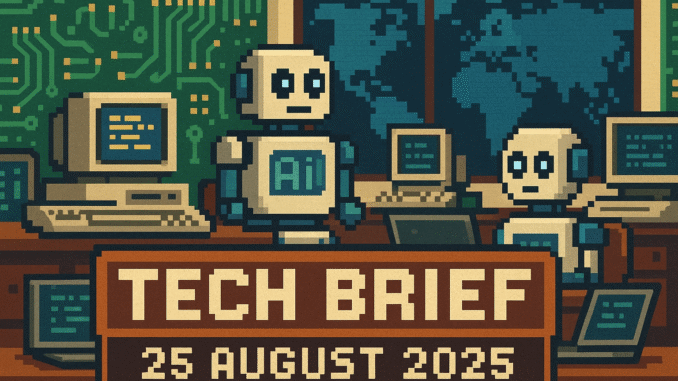
/article>
Tech Brief 25 August 2025 brings more than technical change-up, with shifting AI personalities, multinational debates about who controls our digital future, and a nod to the persistent power of open source. The world never stops tinkering with its tech. Missed yesterday’s Tech Brief? Catch up here before diving in.
Users Mourn the End of ChatGPT-4’s “Soulful” Era
“There’s a hole in my workflow where GPT-4 used to be,” one developer wrote in a forum post collected by The Guardian. OpenAI’s decision to shelve its popular, personality-rich GPT-4 model has created a mini online wake as users grieve losing what felt like a digital friend. The new GPT-5 model is smarter but more businesslike and much less chatty. Developers and writers are comparing it to the mechanical bots of the late 90s, which delivered correct answers yet failed to feel remotely human.
For many, these interactive AIs now return to the emotionless edge of early internet chatbots, with spontaneous communities springing up to share archive “conversations” with GPT-4 for posterity. The nostalgia here isn’t simply misplaced affection-it’s a hunger for the warmth once found in digital spaces and lost in this fresh, efficient, but sterile era. Is AI growing up, or just growing away?
Musk’s xAI Open Sources Grok 2.5, Promising Linux-Style Access
What does open truly mean in 2025? Elon Musk’s xAI is putting its Grok 2.5 model out in the digital wild, letting anyone build on top of it, free of closed-system licensing. That promise, made years earlier, rekindles discussions that once swirled around Linux’s earliest days, where modems screeched and the source was handed out at meet-ups, not behind paywalls. xAI says this is how to accelerate innovation against the likes of OpenAI and Google, but critics are already poking at documentation and code coverage, wary of hidden licence catches.
Developers who dug out Slackware on six floppy disks or ran betas in college labs will know the value of community-driven software. If you spot a callback to open platforms above, it’s deliberate: the open-source dream is restless. Whether this new release returns us to that heady, DIY era or simply decorates another corporate walled garden in “community” trimmings remains to be seen.
Germany Warns of “Existential Digital Dependence” on US Tech Giants
Cloud servers, operating systems, and broadband routers: Germany’s digital ministry is taking stock and doesn’t like what it sees. Lena Wiegmann, minister for digital matters, has described the country’s reliance on American platforms as an “existential threat.” For those who have watched national initiatives like France’s Minitel or Germany’s Bildschirmtext (BTX) fizzle, the announcement feels equal parts déjà vu and warning siren.
The ministry is scrambling to back GAIA-X, Europe’s blueprint for a homegrown cloud, and to pump cash into open-source projects before another SAP-style flop. The language is stark: digital sovereignty isn’t just ambition, it is now survival. Meanwhile, users, developers, and policymakers across Europe weigh up whether this revival of European alternatives will finally shake America’s grip or whether we are “building a tech Maginot Line.” Some would argue that, compared to American giants, even the mightiest Euro project needs more than nostalgia and intent. A working login page is a good start.
US Takes Historic 10% Stake in Intel, Sparking Bitter Debate
President Trump’s administration has converted financial grants to take an equity stake in Intel, meaning the US government now owns a tenth of the iconic chipmaker. Howard Lutnick, Commerce Secretary, calls it “semiconductor sovereignty,” but vocal critics see echoes of government interference from the Reagan era.
At street level, few users will notice a difference on their laptops yet. The deal forces Intel to prioritize American manufacturing, in an echo of 1980s microchip protectionism. Industry analysts wonder: will this safeguard technology jobs or entangle one of tech’s oldest names in slow-moving bureaucracy? Those who remember the “Intel Inside” campaigns and Inmos’s dashed hopes may find the scene familiar, but the stakes are much larger now, a global chip arms race played out in boardrooms.
From the Wayback Machine
On This Day: 1991 – Linux Project Announced
Linus Torvalds shared a Usenet message on 25 August 1991 that changed computing history. His DIY operating system kernel, offered to MINIX users for “practical purposes,” was barely more than a curiosity at first, just bash, GCC support, and a hint of what was possible on a 386 or 486 machine. Linux quickly became the core of the global open-source movement, with everyday users and university hobbyists sharing improvements on forums and mailing lists. By 1993, early adopters were building distributions like MCC Interim Linux that anyone could try on battered home PCs.
Linux, still invisible to many end users, remains everywhere, from web servers to embedded devices. Each new wave of software built on these principles borrows that original, open invitation to build something better.
Today’s Big Question
Tech Brief 25 August 2025 highlights how open source, national tech ambition, and the human side of AI continue colliding. Are we gaining more control or watching new kinds of gatekeeping rise? It might be time to dig out your oldest backup. What would you rebuild?
Stay curious. Even if your weathered mouse mat is from 1997, your take still matters.
Missed yesterday’s Tech Brief? Catch up here

Leave a Reply